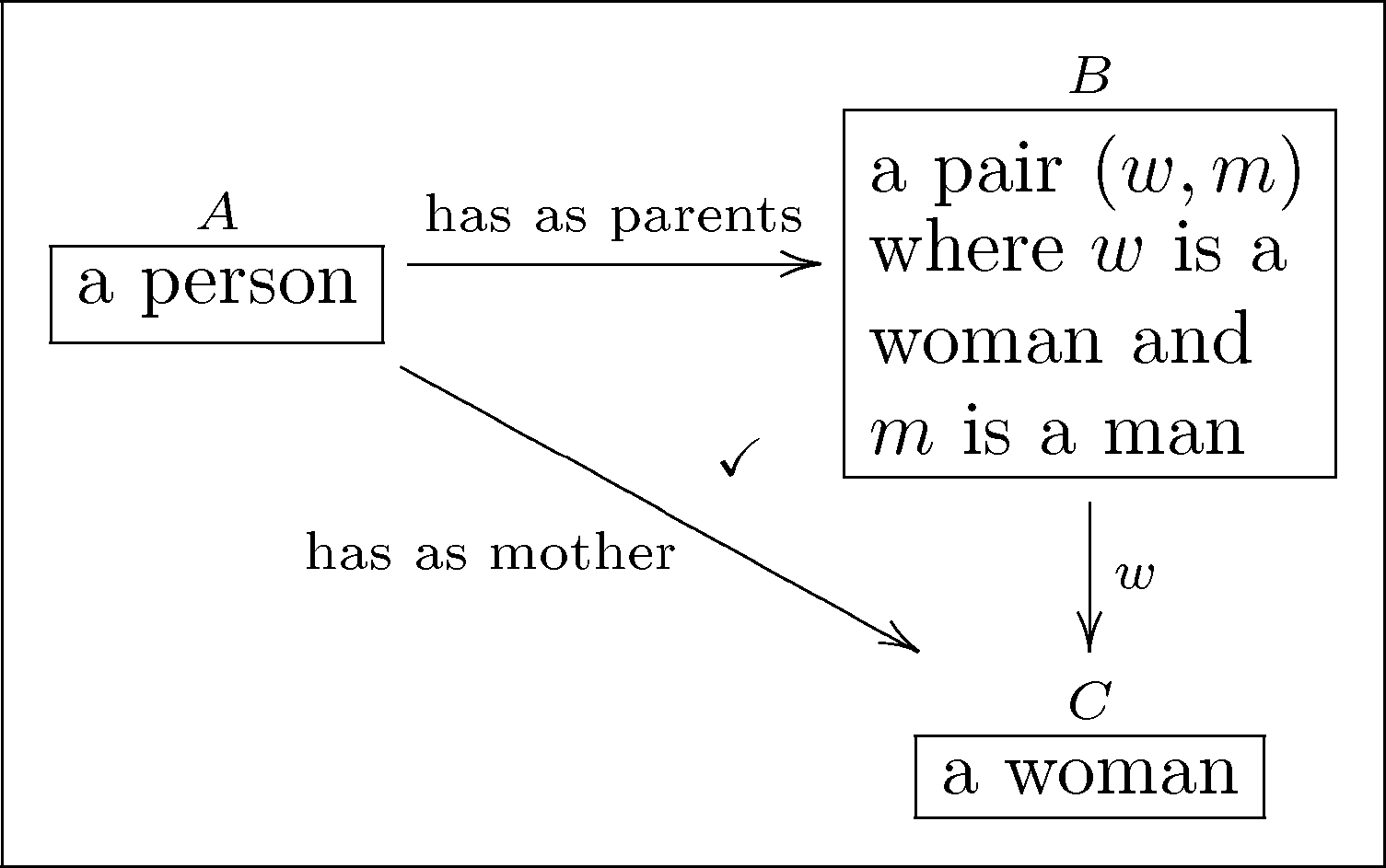Knowledge Representation in Bicategories of Relations¶
⟹
Evan Patterson
Stanford University, Statistics Department
AMS Fall Western Sectional Meeting
Special Session on Applied Category Theory
November 5, 2017
Knowledge representation (KR)¶
"An ontology is a specification of a conceptualization."
—Thomas Gruber, co-founder of Siri, Inc.
New applications motivating KR research:
- Semantic Web (RDF, OWL)
- Ontologies in biology and biomedicine (e.g. Gene Ontology)
Description logic (DL)¶
- Dominant formalism for KR today
- Basis for Web Ontology Language (OWL)
- Computationally tractable subset of first-order logic
- Basic entities:
- concepts (classes)
- roles (relations)
- subsumptions (containments) of concepts/roles
DL examples¶
Syntax and semantics of a few concept constructors:
C⊓DFOL⇝(C⊓D)(x) ↔ C(x)∧D(x)∀R.CFOL⇝(∀R.C)(x) ↔ ∀y.R(x,y)∧C(y)∃R.⊤FOL⇝(∃R.⊤)(x) ↔ ∃y.R(x,y)
Syntax and semantics of concept subsumption:
C⊑DFOL⇝∀x.C(x)→D(x)
Ontology logs (ologs)¶
- Spivak and Kent (2012) introduce ontology logs
- Ologs are a categorical framework for KR
- A (functional) olog C is just a finitely presented category:
- Objects are types in the subject-matter domain
- Morphisms are aspects or properties
- Commutative diagrams encode facts about the domain
- Instance data for an olog is a functor C→Set
- Further expressivity is achieved via
- Limits aka layouts
- Colimits aka grouping
Example olog¶

Relational ologs¶
- Ologs are based on Set, the category of sets and functions
- But description logic is based on relations, not functions
- So what about Rel, the category of sets and relations?
This project is about relational ologs, a categorical-relational framework for knowledge representation.
Goals:
- Explore relationship between logical and algebraic KR
- Develop distinctive advantages of categorical KR
Advantages of relational ologs¶
In contrast to DL, relational ologs provide
- An explicit type system, via objects
- A flexible notion of instance data that cleanly separates universal and particular knowledge, via functors
- An intuitive graphical syntax, via string diagrams
All these features emerge automatically from the categorical framework.
The category of relations¶
Rel, the category of sets and relations, is a monoidal category.
Composition: Given relations R:X→Y and S:Y→Z,
:={(x,z):∃y∈Y.xRy∧ySz}
Cartesian product: Given relations R:X→Y and S:Z→W,
:={((x,z),(y,w)):xRy∧zSw}
Rel as a monoidal category¶
Dagger: Given a relation R:X→Y,
:={(y,x):yRx}
Diagonals: For every set X,
:={(x,(x′,x″)):x=x′∧x=x″}
:={(x,∗):x∈X}
Together they define a family of commutative special †-Frobenius monoids.
Rel as a monoidal category¶
Rel is also a dagger compact category with units and counits defined by
:=
={(∗,(x,x′)):x=x′}
:=
={((x,x′),∗):x=x′}
Rel as a 2-category¶
Rel is a locally posetal 2-category: given relations R,S:X→Y,
R⟹SiffR⊆S.
2-morphisms correspond to subsumptions in DL.
Examples from description logic¶
Intersection of R,S:X→Y:
R⊓S=
Limited existential quantification of R:X→Y:
∃R.⊤=
Abstract categories of relations¶
- How to make a categorical-relational KR system?
- Rel is not sufficient
- Need a finitary specification language
- Two categorical abstractions of relational algebra in literature
- Allegories (Freyd & Scedrov)
- Bicategories of relations (Carboni & Walters)
Bicategories of relations¶
A bicategory of relations is a locally posetal 2-category B that is also a symmetric monoidal category (B,⊗,I) with diagonals (X,ΔX,◊X)X∈B, such that
- every morphism R:X→Y is a lax comonoid homomorphism:
⟹
⟹
- ΔX and ◊X have right adjoints, ∇X:=Δ∗X and ◻X:=◊∗X
- the Frobenius equation holds, making (X,ΔX,◊X,∇X,◻X) into a Frobenius monoid
Relational ologs¶
A relational olog is a finitely presented bicategory of relations.
"Finitely presented" means generated by
- a finite set of basic types or object generators
- a finite set of basic relations or morphism generators
- a finite set of subsumbtion axioms or 2-morphisms generators
Instance data¶
Instance data for a relational olog B is a functor B→D in BiRel, where the data category D is, e.g.,
- Rel or FinRel (the "default")
R=XY122133
- Mat(B), the category of boolean matrices
R=(010100001)
- VectRelk, the category of linear relations
Algebra and logic¶
- Bicategories of relations are
- informally related to description logic
- formally connected to regular logic
- Regular logic: fragment of first-order logic with connectives ∃,∧,⊤,=
- Correspondence: bicategory of relations ↔ regular theories
- Result belongs to categorical logic
- In style of: CCCs ↔ lambda calculus theories
- No subobjects!
Classifying category¶
Every regular theory T has a classifying category Cl(T), a bicategory of relations with
- objects = (equivalence classes of) contexts [x:A]=[x1:A1,…,xn:An]
- morphisms = (equivalence classes of) formulas in context [x:A;y:B | φ]
Internal language¶
Every (small) bicategory of relations B has an internal language Lang(B), a regular theory with
- types = objects of B
- relation symbols = morphisms of B
- theorems = 2-morphisms (subsumptions) of B
Theorem¶
For every (small) bicategory of relations B, there is an equivalence of categories Cl(Lang(B))≃BinBiRel.
Thanks!¶
Paper: E. Patterson, "Knowledge Representation in Bicategories of Relations", 2017 [arXiv]
Background reading:
- Ologs: D.I. Spivak & R.E. Kent, "Ologs: A Categorical Framework for Knowledge Representation", 2011 [arXiv, DOI]
- Description logic: M. Krötzsch, F. Simancik, I. Horrocks, "A Description Logic Primer", 2012 [arXiv]
- Rel: B. Coecke & E.O. Paquette, "Categories for the Practicising Physicist", 2010 [arXiv]
- Bicategories of relations: A. Carboni & R.F.C. Walters, "Cartesian Bicategories I", 1987